Now is the time to understand a few basics about how to do your own tire safety check.
Most of the time, we take our automobile’s tires for granted. Our tires are one of those items in our lives where “out of sight, out of mind” takes precedence. We tend to not take notice of our tires unless something happens, aka a flat tire or, even worse, your tires fail to function in a dangerous situation.
A quick check of the air pressure, and a visual inspection of the tread and sidewall of your tires are proactive steps to avoid tire problems. Listed below are steps to follow when doing a tire safety check to help prevent you from having tire issues in the future.
-
Do a visual inspection of your tires. Things to look for:
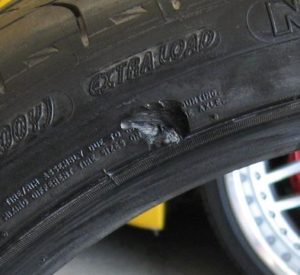 Damage to tire sidewall: This could be in the form of chunks of missing rubber, deep abrasions from hitting curbs, or a bulge in the sidewall. A bulge in the sidewall is likely related to a broken cord inside the tire. This is a serious condition that will almost certainly lead to tire failure. Any chunking larger than a dime, or abrasion that has exposed the textile cords also warrant further inspection. Larger cracks may be an indication of hitting a curb or an impact with a road hazard. All these conditions can be assessed at a tire dealership or auto service center to find out the severity of the damage.
Damage to tire sidewall: This could be in the form of chunks of missing rubber, deep abrasions from hitting curbs, or a bulge in the sidewall. A bulge in the sidewall is likely related to a broken cord inside the tire. This is a serious condition that will almost certainly lead to tire failure. Any chunking larger than a dime, or abrasion that has exposed the textile cords also warrant further inspection. Larger cracks may be an indication of hitting a curb or an impact with a road hazard. All these conditions can be assessed at a tire dealership or auto service center to find out the severity of the damage.
Worn tire tread: No tire safety check is complete without measuring the tread. All tires have a bar in the grooves that is moulded to a height of 2/32nds of an inch. If this bridge in the groove is level with the top of the tread, then you know it is time to change your tires. You can also measure the depth of the tread using a penny. If you can see all of Lincoln’s head, then the tire is due to be replaced.
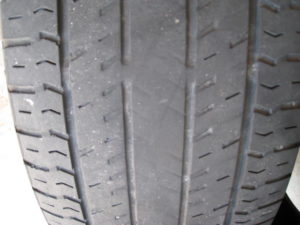 Check the tread for areas that are worn unevenly. This could be a sign of mechanical issues such as worn suspension parts or a wheel misalignment. Irregular wear is more common on the front tires. To inspect the tread, turn the steering wheel all the way to one side so you can see the entire surface of the tread. If there is a wear pattern like the one on the left. you should have your tires rotated and the vehicle inspected for mechanical issues.
Check the tread for areas that are worn unevenly. This could be a sign of mechanical issues such as worn suspension parts or a wheel misalignment. Irregular wear is more common on the front tires. To inspect the tread, turn the steering wheel all the way to one side so you can see the entire surface of the tread. If there is a wear pattern like the one on the left. you should have your tires rotated and the vehicle inspected for mechanical issues.
2. Check the air pressure in all four tires. Adjust as needed:
Regular checks of inflation pressure : This is an often neglected, but important part of any tire safety check. Most late model vehicles have tire pressure monitoring systems (TPMS). These systems alert you to low tire air pressure via dashboard indicator lights. If this happens, be sure to check the tires immediately, including the spare tire.
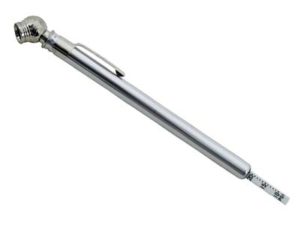 An inexpensive, stick-style pressure gauge should be kept in the vehicle. Use it periodically. This is a good idea even if you have TPMS. The indicator will not alert you if the tires are over inflated. Tires should be checked when they are warm, after a few miles of travel. This is particularly important if the outside temperature is below 40 degrees.
An inexpensive, stick-style pressure gauge should be kept in the vehicle. Use it periodically. This is a good idea even if you have TPMS. The indicator will not alert you if the tires are over inflated. Tires should be checked when they are warm, after a few miles of travel. This is particularly important if the outside temperature is below 40 degrees.
Compare to the recommended inflation : This information can always be found on the vehicle placard on the inside of the driver’s door. Usually there is one pressure for all 4 wheel positions, but occasionally the vehicle manufacturer recommends different pressure on the front and rear axles.
Adjust tire air pressure as needed : If too high, air pressure can be bled out of the tire using the backside of most pressure gauges. You can also insert the top of the valve cap to the valve stem. If the pressure in the tire is too low, most tire dealers or auto service centers will top up your air at no charge. Be sure to not overfill the tires. The tires will perform best, and last the longest at the recommended air pressure.
3. Use the recommended tires for your vehicle, and weather
Tire size and speed rating : If you are not the original owner of the vehicle, it is a good idea to check that the correct size was installed. You also want to ensure the tire has the right service description (load and speed rating). Once you have noted the information off the tire itself, you can compare it to the tire size and specifications listed on the placard inside your driver’s door. If the wheels were changed out for a larger size (often done for a sportier look), the air pressure recommendation remains the same. The speed rating and load capacity should always be the same or greater than the original tire. 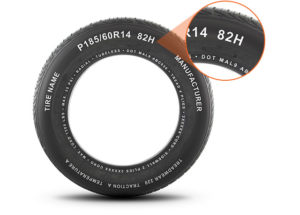 Even if you never intend to travel at the maximum speed, a lower speed rating impacts the way the vehicle handles at all speeds. For example, a vehicle designed for V-rated performance tires that is equipped with T-rated replacement tires would have degraded handling. It would also not brake as well, and would be less responsiveness to steering input. This is particularly problematic in winter driving conditions like heavy rain, or on snow and ice.
Even if you never intend to travel at the maximum speed, a lower speed rating impacts the way the vehicle handles at all speeds. For example, a vehicle designed for V-rated performance tires that is equipped with T-rated replacement tires would have degraded handling. It would also not brake as well, and would be less responsiveness to steering input. This is particularly problematic in winter driving conditions like heavy rain, or on snow and ice.
Tire style : Once you have determined that your tires are the correct size, and have a tire speed rating and load capacity that is equal to, or superior to the recommendation from the vehicle manufacturer, you want to take note of the tread pattern. Some tire treads are optimized for wet and dry roads only (summer tires). Others are for wet, dry, colder weather and light snow (all-season tires). For winter conditions only (wet, slush, cold roads, ice and snow) there are winter tires. Even the highest quality, brand new summer tires are not going to perform in winter conditions, and snow tires are going to wear out quickly in the heat of spring and summer. If you are driving on the wrong type of tire for your climate, an investment in the right tire style will make a big difference in your driving enjoyment and overall safety.
4. Keep informed with up-to-date information about your tires
Tire recalls : When you do a tire safety check, it is easy to take the extra step to validate if there is a recall on your tires. The Rubber Manufacturers Association’s Tire Recall Look-up Tool is an excellent resource. You simply enter the DOT number of your tires in the recall tool. This will tell you if your tire is subject of any investigation or product recall. If so, you are likely entitled to a new set of tires from the manufacturer at no cost! The site has information on the procedures to follow to get your tires replaced.
Consumer Reviews : There are several on-line resources that have product and consumer tire reviews. If you are considering a specific tire brand or style of tire, or simply want to find out what the performance issues may be with your model of tire, sites such as Consumerreports.org can be very helpful.
If you have questions about your tires or tire safety, feel free to give the tire professionals at Postle Tire Barn a call. We can be reached at 205-391-0062.
Postle Tire Barn is a locally owned and operated tire and auto store located in Tuscaloosa, AL. We are located on Jug Factory Road behind McDonalds.

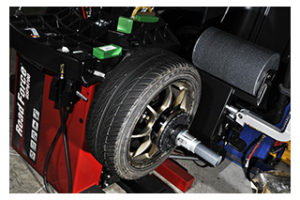
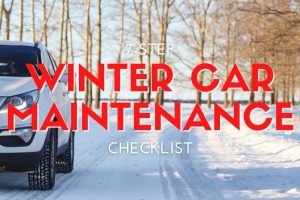
Recent Comments